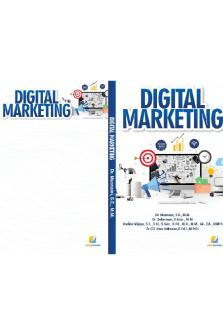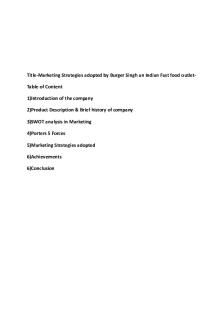Digital marketing strategy Essay PDF

| Title | Digital marketing strategy Essay |
|---|---|
| Course | Digital Marketing Strategy |
| Institution | University of Glasgow |
| Pages | 7 |
| File Size | 126.4 KB |
| File Type | |
| Total Downloads | 5 |
| Total Views | 190 |
Summary
Group work...
Description
A digital Marketing strategy describes how a business uses digital communication options to ensure relationships with their customers, helping to create an online brand. The development of technology has resulted in the rise of Web-based platforms, enabling consumers to interact more efficiently with brands. (Focault 1998). This has had a major impact on how we interact as consumers, making it easier to share knowledge, interact with different cultures and entertain ourselves. (Budden, Anthony, Budden, & Jones, 2011; Kumar, Novak, & Tomkins, 2010). It has also increased opportunities for businesses who successfully introduce a digital marketing strategy, allowing them to identify and target market needs and deliver information to customers instantaneously. (Kierzkowski, et al 1996). Therefore, implementing digital strategies can help companies gain a competitive advantage whilst also remaining relevant with customers. (Phan, 2003) Development of a digital strategy was extremely vital for the expansion of CCA, a centre for contempory arts in Glasgow. This essay will reflect on the knowledge I gained from developing a digital strategy for CCA, looking closely at my experiences of working in a group. Creation of Digital Marketing Strategy for CCA. Researchers agree that the Internet can assist an organisation in brand building, creating W.O.M communication amid customers, crowdsourcing, and buzz marketing. (Whitla, 2009). Businesses must respond to the rapid growth of web-based platforms, implementing a strategy to ensure their digital presence is maintained to a high standard. To successfully exploit the advantages presented by the Internet, companies must use social media as a way of engaging consumers; connecting with stakeholders; and, eventually, creating sales. Social media is a crucial component of any digital strategy, giving companies the opportunity to interact and engage consumers. CCA highlighted in the brief that they wanted to increase their engagement by 5% across all social media platforms, therefore a strategy that incorporated it was essential. Effectively implementing social media helps a business form an 1
online community, increasing interaction between the company and their audience. (Silva et al., 2008). Analysing a firm’s environment is vital when implementing digital marketing strategies, ensuring the continuous growth and development of a company. (Pickton and Wright, 1998). Developing strategic options for CCA allowed me to expand my own knowledge on what is required to develop and successfully implement digital strategies into any business. My group began the project by researching CCA, identifying what they were good at and where there was room for improvement. We used a variety of models to assist the analysis of CCA’s internal and external environment, such as SWOT and PESTLE. SWOT is employed as a valuable management tool (Wilson et al., 1992), looking at a company’s Strengths, Weaknesses, Opportunities, and Threats. It was proposed by academics (Wilson et al., 1992; Johnson and Scholes,1993) as a useful tool for examining both the internal and external factors of an organisation. However, after observing the literature surrounding SWOT, it was evident numerous researchers consider it to be a weak analysis tool (Pickton and Wright, 1998), noting how it was ‘naïve’ in its analysis of the environment, resulting in strategic errors. Even though the value of this model has been debated I found it useful in identifying CCA’s weaknesses, allowing us to suggest strategies to improve. This tool also assisted my group in identifying the opportunities available to CCA, helping in the development of several strategies to combat potential threats. To gain a better understanding of CCA my group decided it would be helpful to look in depth at all aspects of the business, carrying out a detailed analysis of their consumers, competitors, and products. I was given the responsibility of examining CCA’s customers, looking at who they were currently attracting. This analysis allowed me to identify the fact that CCA do not currently have any tactics in place to target a specific audience, rather they aim to engage everyone. Baker (2008) emphasizes the advantage for brands in identifying a target audience 2
before implementing a digital strategy, making it easier to target consumers.. One of CCA’s main campaign objectives is to increase social media engagement by 5%, however, this objective can only be satisfied if CCA are able to identify who they want to engage. Thus, I proposed that CCA concentrate on targeting consumers aged 18-34 years old, concluding that if CCA could successfully introduce a strategy to encourage the participation of this age group, they would notice an increase in engagement both physically and online. Another analysis which aided my group in deciding what strategies CCA should implement was the competitor analysis. This gave us good insight as to what CCA’s rivals were doing, highlighting the aspects of CCA that could use improvement. Whilst it is important for CCA to concentrate on their own strategies, they must also ensure they are exploiting the same opportunities as their competitors. If CCA can successfully look at competitors and recognise what their strengths and weaknesses are it will provide them with a competitive advantage, enabling them to protect themselves against competition within the market. Podcasts The rise in web-based technologies has resulted in endless opportunities for businesses, giving them an array of new advertising techniques to exploit. Our focus in this task was devising a strategy for the successful application of podcasts for CCA. We believed that the consistency of a regular podcast would help to develop CCA’s brand, resulting in the development of an emotional relationship with listeners. (Ashton, 2015). However, during the development of this strategy my group became hesitant about the implementation of podcasts. We were concerned about the cost of equipment against the benefits that would be gained from implementing podcasts, we did not want to propose an expensive strategy that may be unsuccessful. Nevertheless, we continued with the development of this strategy as we believed CCA’s lack of progress was stemming from their poor engagement with their
3
consumers. (Tesseras 2016) Thus, this was an effective strategy in ensuring the continuous development of CCA’s organisation. Timing Another skill I have gained from working in a team environment was how to effectively manage my time, whilst also suggesting realistic strategies for CCA. This skill was not only useful in ensuring our strategies suggested to CCA could be implemented in a realistic timeframe, but it also ensured I was meeting personal objectives set by my team for the completion of this project. This skill was developed with the help of the GANTT chart, which ensured our project could be implemented successfully and realistically. (Maylor, 2001). Working in a team environment In my opinion, creating a digital strategy in a team environment is crucial, as it represents scenarios that will occur in the real world. Team work is evident in several divisions in an organisation, such as human resources, marketing, and finance. This project gave me the opportunity to improve my team-working skills, giving me valuable, transferrable, capabilities that I can develop in the future. Group work is a key facet in the workplace, and if done correctly can have an efficient and productive influence on the organisation. In consonance with Huczynski and Buchanan (2013) a group is two or more people, interacting with each other, with the aim of achieving one cohesive goal. This assignment provided me with a valuable experience, giving me a indication of how to adapt to work in a group, considering everyone shares dissimilar ideas and views, whilst working towards the collective goal of making it work. While, at some points throughout this project our group had to deal with differing opinions and ideas, it was a constructive experience that can be applied in my future. I was apprehensive in the beginning as I prefer to work alone on assignments that carry such a large percentage of the final grade, therefore working in a
4
group was not ideal. Though at times this project was difficult, it has enabled me to gain skills that are needed to effectively work in a team, which will assist me in the development of my future career. Future plans For companies to truly enhance performance and exploit their full potential, a more functional, dynamic team environment is required. Therefore, this project has been very beneficial to the development of my team-working skills. The practical aspect of the assignment has provided me with the skills needed to work in a real-life situation. Before experiencing a task of this nature, I would have preferred to carry out an individual written assignment. However, after carrying out this project I am very happy with the skills I have acquired, which can be applied in my future career. The internet has shown its potential as a marketing tool for companies, it is now down to us to implement strategies to exploit the benefits provided by the web. (Kondopoulos, 2011). Therefore, I believe that any future career choice of mine will involve the application of digital marketing strategies and therefore this experience was invaluable. In conclusion, this task allowed me to better understand how to apply skills practically, rather than writing an essay and not necessarily taking away any new skills.
Word count- 1,500
5
Ashton, D., 2015. Producing participatory media:(Crowd) sourcing content in Britain/Life in a Day. Media International Australia 154(1), pp.101-111. Budden, C. B., Anthony, J. F., Budden, M. C., & Jones, M. A. (2011). Managing the evolution of a revolution: Marketing implications of Internet media usage among college students. College Teaching Methods and Styles Journal, 3(3), 5—10. Johnson, G. and Scholes, K. 1993. Exploring Corporate Strategy. Third edition. Englewood Cliffs, NJ: Prentice Hall. Kierzkowski, Alexa et al. “Current research: marketing to the digital consumer.” The Mckinsey Quartely, Spring 1996 p.180. Kondopoulos, D. (2011). Internet marketing advanced techniques for increased market share. Chimica Oggi-Chemistry Today, 29(3), 9—12. Kumar, R., Novak, J., & Tomkins, A. (2010). Structure and evolution of online social networks. In P. S. Yu, J. Han, & C. Faloutsos (Eds.), Link mining: Models, algorithms, and applications (pp. 337—357). New York: Springer. Maylor, H., 2001. Beyond the Gantt chart: Project management moving on.European Management Journal, 19 (1), pp.92-100 Phan, D.D., 2003. E-business development for competitive advantages: a case study. Information & Management, 40 (6), pp. 581-590. Pickton, D.W. and Wright, S., 1998. What's Swot in Strategic Analysis? Strategic change, 7(2), pp.101-109. Silva, J. M., Mahfujur Rahman, A. S. M., & El Saddik, A. (2008). Web 3.0: A vision for bridging the gap between real and virtual. Proceedings of the 1st ACM International Workshop on Communicability Design and Evaluation in Cultural and Ecological Multimedia Systems (pp. 9—14). New York: ACM. 6
Tesseras, L. 2016. Charities suffering donor apathy - Marketing Week. [Online]. [Accessed 10 December 2017]. Available from: https://www.marketingweek.com/2016/03/14/charitiessuffering-donor-apathy/ Whitla, 2009 P. Whitla Crowdsourcing and its application in marketing activities Contemporary Management Research, 5 (1) (2009), pp. 15-28 Wilson, R. and Gilligan C. with Pearson, D. 1992. Strategic Marketing Management. Oxford: Butterworth-Heinemann.
7...
Similar Free PDFs

Digital marketing strategy Essay
- 7 Pages

Marketing Strategy
- 5 Pages

marketing strategy
- 5 Pages

Digital Marketing
- 10 Pages

DIGITAL MARKETING
- 127 Pages

MARKETING DIGITAL
- 15 Pages

Hyundai\'s Marketing Strategy
- 3 Pages

LG\'s marketing strategy
- 3 Pages

PMK-Apple\'s marketing strategy
- 26 Pages

Netflix marketing strategy
- 2 Pages

International Marketing Strategy
- 68 Pages

Burger singh marketing strategy
- 16 Pages
Popular Institutions
- Tinajero National High School - Annex
- Politeknik Caltex Riau
- Yokohama City University
- SGT University
- University of Al-Qadisiyah
- Divine Word College of Vigan
- Techniek College Rotterdam
- Universidade de Santiago
- Universiti Teknologi MARA Cawangan Johor Kampus Pasir Gudang
- Poltekkes Kemenkes Yogyakarta
- Baguio City National High School
- Colegio san marcos
- preparatoria uno
- Centro de Bachillerato Tecnológico Industrial y de Servicios No. 107
- Dalian Maritime University
- Quang Trung Secondary School
- Colegio Tecnológico en Informática
- Corporación Regional de Educación Superior
- Grupo CEDVA
- Dar Al Uloom University
- Centro de Estudios Preuniversitarios de la Universidad Nacional de Ingeniería
- 上智大学
- Aakash International School, Nuna Majara
- San Felipe Neri Catholic School
- Kang Chiao International School - New Taipei City
- Misamis Occidental National High School
- Institución Educativa Escuela Normal Juan Ladrilleros
- Kolehiyo ng Pantukan
- Batanes State College
- Instituto Continental
- Sekolah Menengah Kejuruan Kesehatan Kaltara (Tarakan)
- Colegio de La Inmaculada Concepcion - Cebu



